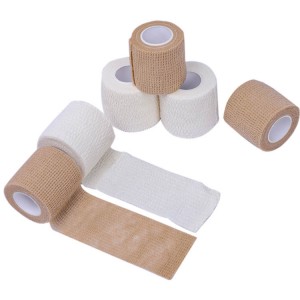1. Medical plaster bandage fixation for fractures
Medical plaster bandage real shot
It is a fine powder of plaster of paris (anhydrous calcium sulfate) sprinkled on a special sparse-hole gauze bandage. It is made into a medical plaster bandage, soaked in warm water, and wrapped around the patient's limb to be immobilized. It can be hardened and formed in 5 to 10 minutes, and gradually dry and firm, which can effectively immobilize the affected limb. In recent years, the use of resin bandages for immobilization has increased day by day.
Indications for medical plaster bandage fixation (1) after debridement and suturing of open fractures, before the wound heals (2) fractures in certain parts, those who are difficult to fix with small splints; (3) after open reduction and internal fixation of certain fractures , such as intramedullary nailing or plate screw fixation of femoral fractures, as auxiliary external fixation; (4) maintenance of orthopedic position after deformity correction and fixation after bone and joint surgery, such as after wrist joint fusion; (5) suppurative Immobilization of limbs affected by arthritis and osteomyelitis.
Advantages and disadvantages of medical plaster bandage fixation (1) Advantages: It can be shaped according to the shape of the limb, and the fixation effect is reliable and can be maintained for a long time. (2) Disadvantages: inelastic, can not adjust the tightness, the fixed range is large, generally must exceed the upper and lower joints of the fractured part, cannot carry out functional exercise of joint activities, and easily causes joint stiffness.
Clinically, fracture patients often have other diseases, such as diabetes, which requires nursing staff to pay attention to diabetes care and try to avoid infection, because diabetic patients are prone to infection and non-healing of wounds, and their diet It is best to ask a nutritionist doctor for consultation to promote the patient's speedy recovery.
2. Indications for plastering of fractures
Fractures are present in life today. Can be frequent. Many times because of not paying attention to their own care and health care. some accidents. It is also easy to cause fractures naturally, which gives our normal life work. will have an impact. Because it takes 100 days to hurt the muscles and bones, so the following will give you a detailed introduction. Which fractures require a cast?
For arm fractures, it usually takes one month to remove the plaster. It is too early to remove the plaster after only two weeks. The fracture site has not been properly connected for a long time, which may easily cause displacement, cause deformity, and affect future functions. It is recommended to go to the hospital to review X-rays to confirm Is the location normal now? If it is abnormal, it must be dealt with in time. If the fracture is now well aligned, continue the cast.
The itching of the arm is caused by the exfoliation and necrosis of the epidermis caused by the poor blood circulation caused by the plaster fixation. It does not matter. After the plaster is removed, it will fall off naturally. One month after the removal of the plaster cast, it is necessary to strengthen functional exercises to fully recover.
Indications 1. After reduction of stable fractures. 2. Spinal compression fractures. 3. After joint dislocation reduction. 4. Joint sprain, ligament tear and avulsion. 5. Promote healing and prevent pathological fractures after surgery, such as nerve anastomosis, tendon transplantation, ligament suture, joint fusion and fixation, osteotomy, bone transplantation, joint transplantation, microsurgery, osteomyelitis, etc. 6. After open reduction and internal fixation of fractures. 7. Correct congenital deformities, such as congenital hip dislocation, congenital clubfoot, etc. 8. Chronic osteoarthritis, osteoarthritis infection, cervical spine injury, etc. 9. Plaster beds and vests before and after spine surgery. Contraindications 1. The general condition is poor, especially the elderly with insufficiency of heart and lung function, medical plaster bandages should not be wrapped on the chest and abdomen. 2. Pregnant women and progressive ascites should not use chest and abdomen plaster. 3. When there are special circumstances that directly hinder the observation of the disease.
Medical plaster bandage immobilization of fractures Precautions after plaster immobilization of fractures
If a fracture occurs, of course, you must pay attention to timely recovery of the fractured part. After all, if you cannot restore it to the original position for a long time, it will have a great impact on the later rehabilitation, so everyone should pay attention to it. Taking effective treatment methods, these parts should also be protected in daily life.
Three, 6 major precautions after fracture plaster immobilization
Six precautions after fracture plaster immobilization. Orthopedic experts pointed out that medical plaster bandages are often needed for fixation after fracture surgery. The advantage of this method is that it can be shaped according to the shape of the affected limb and the fixation effect is firm and reliable. Disadvantages such as stiffness of the joints. Therefore, we should pay close attention to it, give full play to its advantages and put an end to its disadvantages so as to promote the recovery of fractures as soon as possible. The following points should be paid attention to after the fracture medical plaster bandage is fixed:
1. Pay attention to maintaining the fixed position until the plaster is completely solidified. Under normal circumstances, the medical plaster bandage can reach its maximum strength after being fixed for 24 hours.
2. Care should be taken to avoid breaking the plaster when moving and transporting the patient. If it is broken, it should be repaired by a doctor in time.
3. After the medical plaster bandage is fixed, the affected limb should be raised to prevent swelling caused by poor blood return of the local tissue. After the plaster is completely solidified, the functional exercise of the unfixed joint can be carried out.
4. Closely observe the blood circulation, sensation and movement of the distal end of the affected limb. If there is severe pain, numbness, low temperature of extremity skin or dark color of fingers/toes, etc., it indicates that the plaster is wrapped too tightly and severe compression symptoms have occurred. Remove the plaster.
5. After the swelling of the affected limb fixed by the medical plaster bandage disappears, if the plaster fixation is too loose, the plaster should be replaced in time to ensure effective orthopedic and fixation effect.
6. When the ambient temperature is too low, it is necessary to strengthen the warmth of the fixed part of the medical plaster bandage to prevent swelling of the distal end of the affected limb due to cold.
Fourth, what are the hazards of fractures?
As the saying goes, it takes a hundred days to hurt your muscles and bones. It is believed that fractures are very common in our daily life, it not only brings us pain but also brings great trouble. Many people may think that most fractures are caused by calcium deficiency or external forces, but is this really the case? In fact, in daily life, some inadvertent small movements may also hurt your bones.
(l) Hypostatic pneumonia: It mostly occurs in patients who are bedridden for a long time due to fractures, especially those who are old and frail and accompanied by chronic diseases. This can sometimes endanger the patient's life. The thinker should be encouraged to get out of bed as soon as possible. .
(2) Decubitus: After a severe fracture, the patient is bedridden for a long time, the bony protrusions of the body are compressed, and the local blood circulation disorder is easy to form a bedsore. Common sites are the energy bone, broken, and heel.
(3) Deep vein thrombosis of lower extremities: more common in pelvic fractures or lower extremity fractures, prolonged immobilization of lower extremities, slow venous blood return, and hypercoagulability caused by injury, thrombosis is likely to occur. Exercise should be strengthened to prevent its occurrence.
(4) Infection: In open fractures, especially those with heavy pollution or with severe soft tissue damage, infection may occur if the debridement is incomplete, residual necrotic tissue or poor soft tissue coverage. Improper handling can cause suppurative osteomyelitis.
(5) Injury ossification: also known as myositis ossificans. Due to joint sprain, dislocation or fracture near the joint, the periosteum is peeled off to form a subperiosteal hematoma. Improper handling causes the hematoma to expand, organize and extensively ossify in the soft tissue near the joint, resulting in severe joint dysfunction. Especially common in the elbow joint.
(6) Injurious arthritis: Intra-articular fractures, the articular surface is damaged, and the articular surface is not accurately reset. After the bone heals, the articular surface is uneven. Long-term wear and tear can easily cause arthritis of the damaged part, resulting in pain during joint movement.
(7) Stiffness of the joints: The affected limbs have been immobilized for a long time, the venous and lymphatic return is not smooth, and there is fibrous exudation of serous fluid and fibrin deposition in the tissues around the joints. Fibrous adhesions occur. Accompanied by joint changes and contractures of peripheral muscles, resulting in joint movement disorders. This is the most common complication of fractures and joint injuries. Timely removal of fixation and active functional exercise are effective methods to prevent and treat joint stiffness.
(8) Acute bone atrophy: the diseased osteoporosis near the joints caused by injury, also known as reflex sympathetic osteodystrophy.c Occurs after fractures of the hands and feet, and the typical symptoms are pain and vasomotor disturbances.
(9) Avascular necrosis: A fracture occurs when the blood supply of a certain fracture segment is destroyed, resulting in avascular necrosis of the fracture segment. A common avascular necrosis of the proximal fracture segment after wrist scaphoid fracture.
(10) Ischemic muscle contracture: It is mostly a serious consequence of improper treatment of compartment syndrome and is one of the most serious complications of fractures. It can be caused by fractures and soft-tissue injuries, and is often caused by improper fracture management, especially if the external fixation is too tight. One-day occurrence is difficult to treat and often leads to severe disability. Typical deformities are claw hands and claw feet.
KENJOY is a manufacturer of medical plaster bandages in China. Wholesalers of medical plaster bandages, Exporter of medical plaster bandages
Learn more about KENJOY products
Post time: Aug-13-2022





